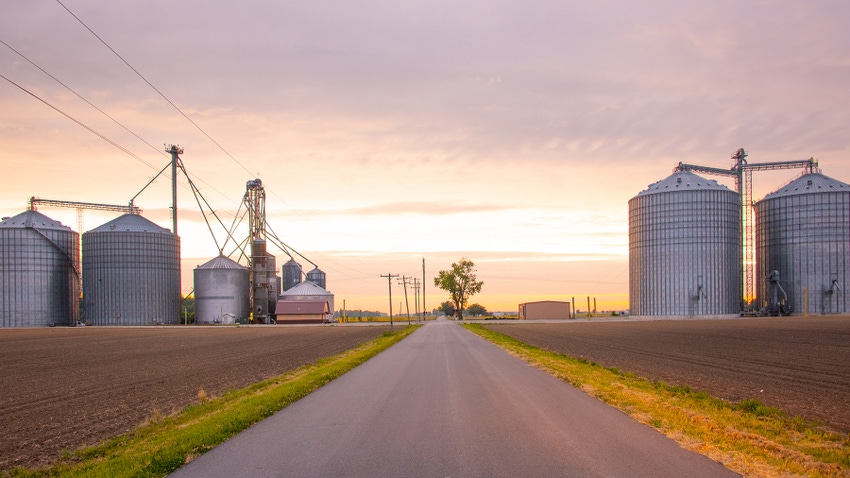
There has been a lot of market chatter this winter about farmers being undersold on 2023/24 corn sales. A January 2024 Farm Futures grower survey sheds some light on these coffee shop conversations, though it remains a hard metric to quantify for several reasons.
First, USDA only takes stocks data four times a year. That data is self-reported by farmers and commercial storage facilities. Measuring storage capacity is no small feat either, because anyone who has driven through the Corn Belt in the fall knows temporary storage can be constructed out of thin air.
And who is measuring those giant grain piles down to the bushel?! As someone who spent a chunk of her career taking inventory of raw materials and final products at cheese plants, I want to know!
Doing backwards math from USDA’s quarterly stocks and beginning supplies data gives us usage estimates, which are a close proxy for crop volumes sold, though it isn’t perfect math. Those estimates suggest that 31.3% of anticipated 2023/24 corn consumption already occurred between Sept. 1, 2023 and Dec. 1,2023, which is perfectly aligned with the average of the prior 13 marketing years.
Second, conversations about the rate at which farmers are selling grain often leave out a lot of context. Brokers may say that farmers are “undersold,” but is that relative to the prior marketing year or a multi-year average? And does that metric include bushels priced or just bushels delivered?
Third, and perhaps most importantly, crop sizes and beginning supplies change every year. Farmers harvested a record-setting corn crop in 2023, so it goes without saying that farmers had – and likely still have – more corn bushels on hand to market than at the same time last year.
Fourth (and this is more of a personal observation), you’ll note that a lot of these conversations about farmers being undersold on corn cannot be traced back to measurable and/or published data. You’ll also observe that many of these voices have a financial interest in farmers selling their crops. We are all working for the farmer to be financially successful here, but I found that to be an interesting bias when observing these conversations over the past couple months.
What does the data say?
Results from the Farm Futures grower study find that farmers are becoming more proactive with their marketing plans as prices drift lower following multiple profitable years, thanks to higher commodity prices received.
Through Dec. 31, 2023, growers told Farm Futures they had sold 61% of their 2023/24 corn crop. That is up 8% from the same time a year prior, suggesting that farmers took falling corn prices over the past nine months to heart and tried to get ahead of falling prices.
Those that did experienced little fear of missing out (or FOMO, as the kids are calling it). Nearby May 2024 corn futures fell another $0.51/bushel (11%) in the first eight weeks of 2024 after closing 2023 down 30% ($2.06/bushel).
Soybean prices did not fall as steeply as their corn counterparts during 2023, only falling 15% on the year. But waning export demand from China and a large crop looming in Brazil led growers to accelerate soybean sales late last year, with farmers in the Farm Futures survey reporting being 72% sold on 2023/24 soybeans as of Dec. 31, up 10% from the same time a year prior.
Wheat prices experienced significant price erosion over the past year, especially after Ukraine successfully transported grain via its humanitarian corridor in the Black Sea and Russia harvested a bumper crop. Nearby Kansas City futures fell 27% lower in 2023 while soft red winter wheat contracts in Chicago lost 20% of their value during that time.
Farm Futures readers sold 91% of their 2023/24 wheat crops as of Dec. 31, an eye-popping 30% higher than the same time a year prior. This number looks slightly bigger than corn and soybeans at the same time in late Dec. largely because wheat is harvested earlier than those crops. But amid stiff competition in the export market from the Black Sea, it seems likely that U.S. wheat growers were unwilling to take unnecessary risks with post-harvest sales as 2023 ended.
Author’s note: Please note on these graphs that the values don’t all sum to exactly 100%. This is due to taking the average of producers’ responses. But it is still helpful in evaluating trends – on-farm storage for all three primary crops is lower this year and sold rates through the end of 2023 were higher. Interestingly, growers are utilizing more off-farm storage for corn and wheat this year than they are for soybeans.
Hedging bets
On a percentage basis, farmers are likely ahead of historical paces on 2023 crop sales. But there are so many more corn bushels on the market following last fall’s record harvest – especially relative to the past few years – that substantial volumes of old crop corn remain in storage ahead of bins being cleared out this summer to make room for the 2024 crop.
Slightly higher 2023/24 beginning stocks are also a factor in the larger crop inventories estimated across the Heartland. Farmers in the recent Farm Futures survey reported holding back slightly more 2022 corn and soybeans last fall than they had the previous year, adding to supply volumes.
About the Author(s)
You May Also Like






